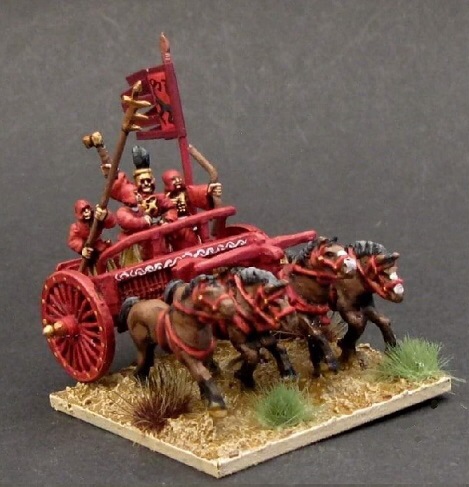
This period in Chinese history is named after the Spring and Autumn Annals attributed to Confucius, which are the main narrative source for the period's history. It is also called the Early Eastern Chou (or Zhou) Period. The period saw central Chou control over the great feudal states of China decline, and much resulting warfare between them in order to consolidate their power, as well as with the fierce tribes of Northern Barbarians. Chinese warfare in this period was ritualized and revolved around chariot warfare, and battled often involved huge numbers of chariots and men. As a result we have made many crewmen for the chariots in order to allow you to vary your force as much as possible -- each superset of chariots comes with ten different men, two generals and eight drivers/fighters.
Important foes, and sometimes allies, of the great Chinese houses were the Northern Barbarians, and foremost among them in this period were the Ti, also called Di, or Beidi ("northern Di"), and the Rong, sometimes called Xirong. One Di tribe, the Red Di, constituted a major military menace in the seventh century BC, nearly destroying two great feudal states. The Rong were similarly dangerous, or even more so! Despite the perception that they were "barbarians," a Di tribesman, Hu Yan, was rated by Han historians as one of the greatest generals of the Spring and Autumn period, right beside Sun Tzu -- Hu Yan served the great feudal Chinese state of Jin, showing how these so-called "barbarians" were to be found in Chinese service as well. In fact, it's thought that several small states were strongly influenced by the Di and may even have been founded by them.
Notes on the figurines:
In this period, trousers had not yet been adopted, and the infantry are represented without them. The chariots are still depicted with a drawbar only long enough for two horses, the outer two horses being apparently attached to the inner horses rather than to the drawbar. As a result, half of the horses have the yoke with the medallion on top, and these should be the inner pair of horses. The drawbar would be placed in front of the medallion when assembling the chariots.
Some army lists separate out the armies of the Red Di into master race and subject tribe bases, and to accommodate that we have made several different types of tribal warrior, from nobles down to subjects. If your game system does not distinguish, you can use the subjects as second rank bases, or just mix them all up.
|

